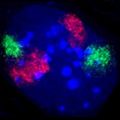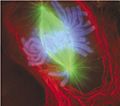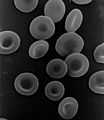Cell nucleus facts for kids
The cell nucleus is like the control center of a cell. It's a small, round part inside most cells that holds all the important instructions for the cell to work. These instructions are stored in something called DNA, which is organized into structures called chromosomes.
Think of it this way: the nucleus tells the cell what to do, when to grow, and when to divide. Most cells in your human body have a nucleus.
All eukaryotes, which include animals, plants, fungi, and many single-celled organisms, have cells with a nucleus. But bacteria and Archaea are different types of single-celled organisms called prokaryotes, and their cells do not have a nucleus.
Scientists first discovered cell nuclei way back in the 17th century, thanks to Antonie van Leeuwenhoek.
Inside the nucleus, there aren't many separate compartments with membranes. However, it's not just a uniform blob! There are special areas called sub-nuclear bodies. These areas are made of unique proteins, RNA molecules, and specific parts of the chromosomes. The most famous of these is the nucleolus.
The nucleolus is mainly involved in making ribosomes. Ribosomes are like tiny factories that build proteins. Once ribosomes are made in the nucleolus, they travel out into the cytoplasm (the jelly-like substance filling the cell). There, they use instructions from mRNA to create all the proteins the cell needs.
When a cell is getting ready to divide, or is in the middle of dividing, its chromosomes become visible under a light microscope. At other times, when the chromosomes are not visible, you can usually see the nucleolus clearly.
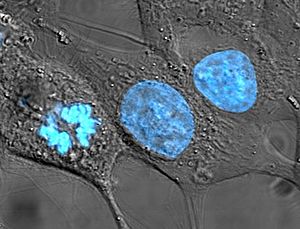
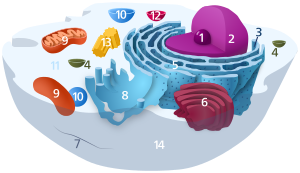
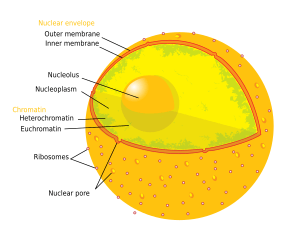
Contents
The Nuclear Membrane: A Cell's Protective Wall
The nucleus is surrounded by a special double-layered wall called the nuclear membrane. This membrane is very important because it controls what goes in and out of the nucleus. Large molecules usually can't pass through it easily.
However, the nuclear membrane has tiny openings called nuclear pores. These pores act like gates, controlling the movement of molecules. They go through both layers of the membrane, creating channels. Small molecules and ions can move freely through these pores. But larger molecules, like proteins and RNA, need special "carrier proteins" to actively transport them across. This movement is vital for gene expression (when genes are used to make proteins) and for keeping the chromosomes in good shape.
The Nucleolus: Ribosome Factory
Inside the nucleus, there's a distinct structure called the nucleolus. It forms around a specific area on a chromosome known as a nucleolus organizer region (NOR).
The main job of the nucleolus is to make ribosomes. As mentioned before, ribosomes are essential for building proteins. Once ribosomes are made in the nucleolus, they are sent out through the nuclear pores into the cytoplasm. In the cytoplasm, they get to work, assembling proteins. Some ribosomes even attach to the endoplasmic reticulum if they are making proteins that will be part of cell membranes.
Images for kids
-
HeLa cells stained for nuclear DNA with the blue fluorescent Hoechst dye. The central and rightmost cell are in interphase, thus their entire nuclei are labeled. On the left, a cell is going through mitosis and its DNA has condensed.
-
A mouse fibroblast nucleus in which DNA is stained blue. The distinct chromosome territories of chromosome 2 (red) and chromosome 9 (green) are stained with fluorescent in situ hybridization.
-
An electron micrograph of a cell nucleus, showing the darkly stained nucleolus
-
Macromolecules, such as RNA and proteins, are actively transported across the nuclear membrane in a process called the Ran-GTP nuclear transport cycle.
-
An image of a newt lung cell stained with fluorescent dyes during metaphase. The mitotic spindle can be seen, stained green, attached to the two sets of chromosomes, stained light blue. All chromosomes but one are already at the metaphase plate.
-
Oldest known depiction of cells and their nuclei by Antonie van Leeuwenhoek, 1719
See also
 In Spanish: Núcleo celular para niños
In Spanish: Núcleo celular para niños



